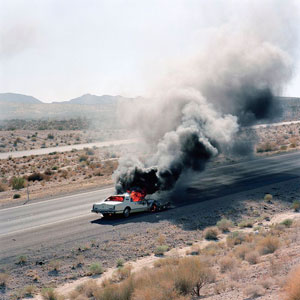4.14.25 — Photography as Spectacle
You may remember Weegee for one thing, a freak show, but never forget: freaks are people, too. They may even be celebrities.
With wide eyes and contorted faces, they are not a pretty picture, but society’s picture all the same. Riven by shadow, they are used to stage lighting as well. In a retrospective subtitled “Society of the Spectacle,” at the International Center of Photography through May 5, they become more and more glamorous, too. Above all, a freak show really is a show, and Weegee sees one on both sides of the camera, as the paparazzi crowd in.  The ambiguity of photojournalism and dark comedy has haunted photography ever since. Just this past fall, Jeff Brouws dares you to find anything wrong in the American scene, while Mary Mattingly watches the dark side of the natural world come out at night—and I wrap this together with recent reports on them both as a longer and fuller review and my latest upload.
The ambiguity of photojournalism and dark comedy has haunted photography ever since. Just this past fall, Jeff Brouws dares you to find anything wrong in the American scene, while Mary Mattingly watches the dark side of the natural world come out at night—and I wrap this together with recent reports on them both as a longer and fuller review and my latest upload.
Weegee had one name but many lives, much like the New York he portrayed in photography, and yet he kept coming back to the spectacle, much like the city itself. Born Arthur Fellig in Ukraine at the turn of the century, he made a career as the police photographer who kept one step ahead of the police. It gave him a name compounded from Ouija and squeegee, for the man with a police-band radio, a sixth sense, and whatever tools it took to make the streets his darkroom. If the cops had their perp walk, Weegee was there, with his cigar and flashbulb. Chasing fires, crime, and car wrecks, he might even get there first. He took his self-portrait in a police van, staring right back.
This was the New York street photography of Helen Levitt and William Klein, with an emphasis on the urban underground. It anticipates the madness of Diane Arbus and Garry Winogrand still to come. He called his first book, in 1945, Naked City—but then, in 1947, he packed up for Hollywood, where crime was legit because you could make it up. He joined the wall of photographers at a press opening, and he turned the camera around to capture them as well. You can all but hear the flash go off. It penetrates the Hollywood darkness as far as he wished to go.
The curator, Clément Chéroux of the Fondation Henri Cartier-Bresson, describes a second career. I am not so sure. His technique stayed the same, with a strong depth of field and extreme contrasts in brightness. When he photographs a fire, smoke can be anything from mud gray to the reflection off the firefighters’ lights. In LA, the men wear white shirts and black ties, and stage lights are just part of the show. In his last decade, the 1060s, Weegee left for Europe and yet another life, but where would Paris be without the night?
The show draws freely on ICP’s collection, with the Weegee Archive, which it owns. It takes its publicity image from LA, but the rest leans heavily on his years in New York. It might be missing a lot that way, except that his subject had not changed all that much either. Had he turned from fires, crime, and car wrecks to celebrities—and from the hard boiled to the cheesy? He was always taking the measure of human lives, from the start. Even a crashed car was a portrait.
Had he turned, too, from the crime scene to what lay behind the camera? Like Arbus herself, he was always conscious of action on the fringes. That includes the suspects themselves, but also the entirety of a city in turmoil, black and white. He heads for Coney Island visitors and bar regulars in search of relief. He looks up to families seeking rest on a fire escape in the head of summer. He might have seen himself, his restlessness, and his cigar.
The show’s title quotes Guy Debord, the French theorist, making Weegee a postmodernist before his time. It refers as well, ICP argues, to a society of spectators, like Wee himself. For him, they were never all that different from each other—or the criminals from the stars. When suspects hide their face from police photography’s cameras, they were putting on a mask and a show. Late in life, the photographer’s lens itself creates the mask, with paintings as popular as the Mona Lisa but with wide eyes and distorted faces. Parody, sympathy, and honesty point to comedy, tragedy, and art.
Read more, now in a feature-length article on this site.